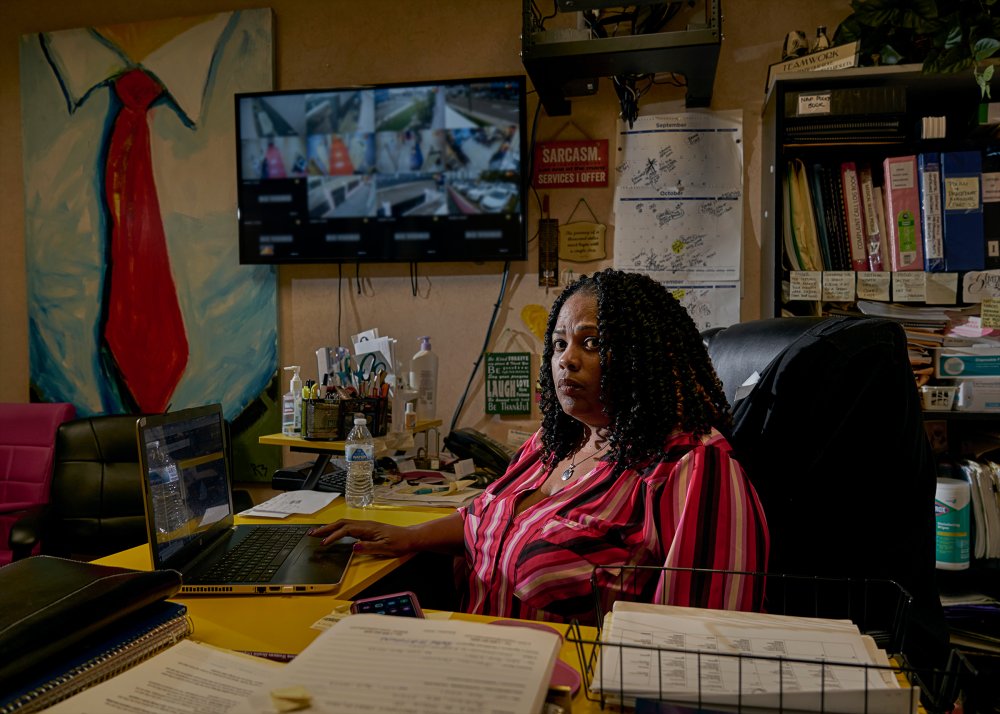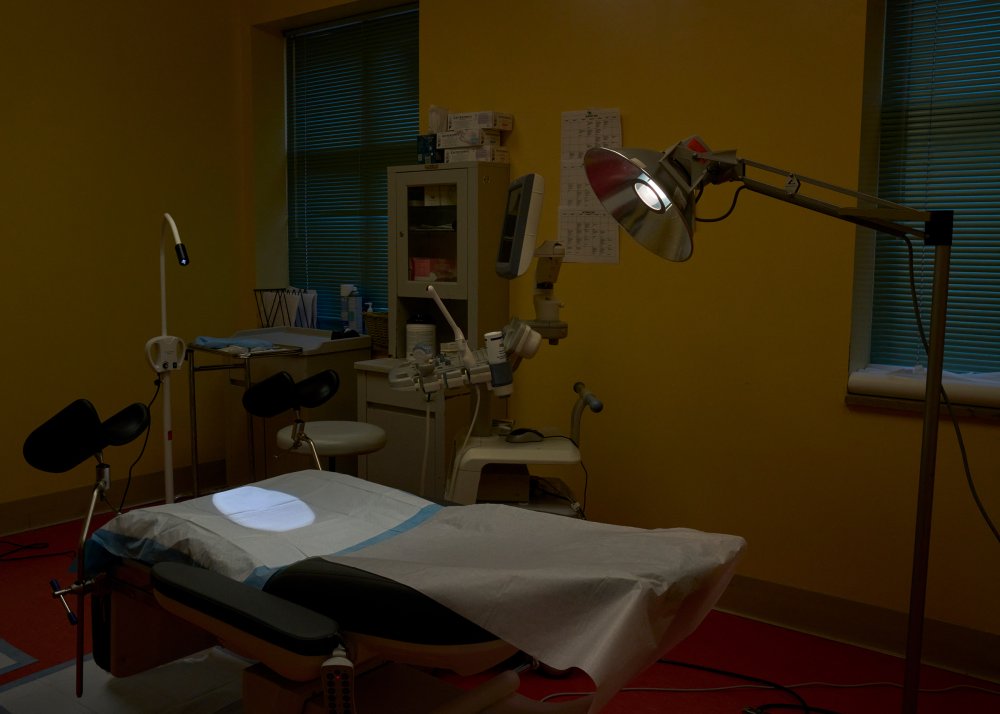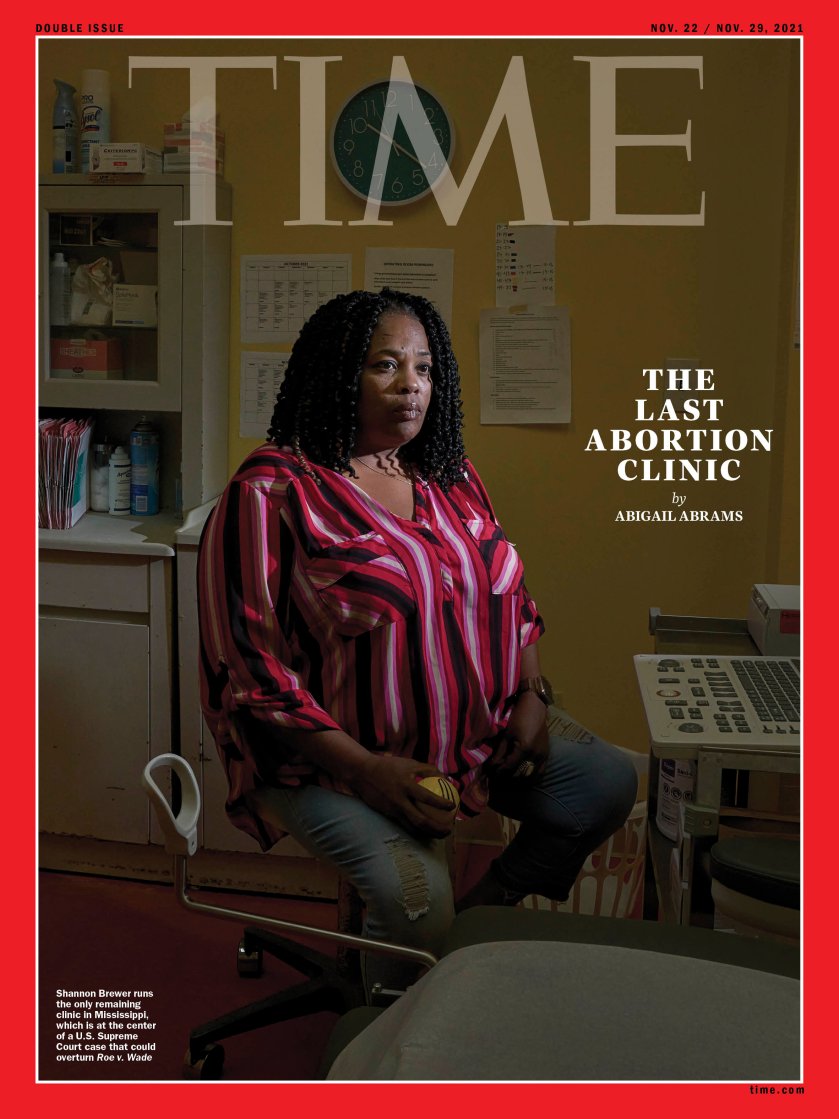
Jackson Women’s Health Organization is at the center of a Supreme Court case that could overturn Roe v. Wade
Shannon Brewer’s eyes dart to a grid of grainy images on a wide, black screen above her desk at the Jackson Women’s Health Organization (JWHO). Live footage shows a large truck creeping into the clinic’s parking lot, its side emblazoned with a pair of blue, ghostly baby feet and the words Where are our children? Brewer doesn’t recognize the driver. Her spine stiffens.
As the director and de facto head of security at the last abortion clinic in the state of Mississippi, Brewer is not easily spooked. In her two decades there, she has seen bomb scares and stalking incidents, and protesters getting in fights with her staff. She keeps the number of an FBI contact amid a sea of sticky notes beside her desk. But this year, she says, everything feels more intense. More dangerous. More consequential.

Her clinic, known as the Pink House for its bubble-gum-colored exterior walls, is at the epicenter of the fight over abortion access, in Mississippi and the country. On Dec. 1, the U.S. Supreme Court will hear arguments in a case, Dobbs v. Jackson Women’s Health Organization, about a Mississippi state law banning nearly all abortions after 15 weeks of pregnancy. If the court allows the law to remain in effect, the decision will effectively hollow out Roe v. Wade, the landmark 1973 decision that established a constitutional right to an abortion before fetal viability. “This is not gonna just affect Mississippi,” Brewer says. “It’s gonna affect women everywhere.”
Five years ago, this moment was unthinkable. Even the Supreme Court’s decision to take up a case that directly challenges Roe would have been considered outlandish, legal scholars say. But the landscape has shifted rapidly. Over the past year, GOP-controlled state legislatures have passed a record-breaking 106 abortion restrictions, including a Texas statute that bans nearly all abortions after roughly six weeks of pregnancy. Conservative state and federal judges have allowed some of those laws to stand, while President Trump’s appointment of three Justices—Neil Gorsuch, Brett Kavanaugh and Amy Coney Barrett—has put Roe at risk. Dobbs v. Jackson Women’s Health Organization will come before the most conservative bench in decades.
Anti-abortion activists are energized. In a normal year, the Pink House has its share of regular protesters, but ahead of the December hearing, “abortion tourists,” as the clinic volunteers call them, have begun showing up on the sidewalk every day. Melissa Fowler, chief program officer at the National Abortion Federation, which tracks threats to abortion clinics, says she’s heard from members “who report an escalation in anti-abortion rhetoric, criminal activities and the intensity of activities” since last year.

Brewer herself has become a lightning rod. “She thinks she’s doing a good thing,” says Barbara Beavers, who was trying to discourage patients from entering the Pink House in October. “But she’s killing babies.” Coleman Boyd, a local physician who regularly protests outside the clinic with his wife and children, also calls out Brewer by name. She and her staff, he says, “have a heart to kill.”
It’s in this context that Brewer, one eye still trained on the security footage, walks out the clinic’s front door and strides over to the unfamiliar truck, idling a few yards from the building. She exchanges words with the driver, then rolls her eyes and flashes a nod of assurance to her staff. The truck is part of a national anti-abortion group’s protest that evening. Nothing to worry about.
Back at her desk, in front of a sign reading Queen Warrior, Brewer considers the enormity of her role in the moment—the last director of her state’s last abortion clinic, just weeks before the most momentous high-court hearing on abortion in a generation. “I’m going to appreciate the time that we have,” she says. “Once we go to court, every day that we are open and see patients and get to talk to them—it’s like we don’t know if this is the last time.”
Abortion wasn’t always such a partisan subject in America. Nearly a half-century ago, when the Supreme Court decided Roe, the ruling wasn’t as polarizing as it is now, says Mary Ziegler, a law professor at Florida State University and an expert on the legal history of abortion. Republicans kept the issue at arm’s length, wary of anti-abortion activists who they saw as “wild children,” she says; Democrats rarely discussed it at all.
That began to change in the 1980s, Ziegler explains, when a cadre of GOP strategists seized on abortion as a way to animate the religious right and win over voters who might otherwise lean left. These activists began to test the limits of Roe, working closely with state lawmakers to pass new abortion restrictions, such as mandated waiting periods or minimum measurements for clinics’ rooms and corridors.
That legal strategy was supercharged by a 1992 Supreme Court decision, Planned Parenthood v. Casey, in which the Justices ruled that states could restrict abortion so long as they did not impose an “undue burden” on patients. In the three decades since, the number of laws restricting abortion multiplied. Abortion opponents framed many of these new rules as protections for women’s health, but doctors often -described them as medically unnecessary.
“It’s simply that the enforcement of these regulations would make it hard to keep clinics open,” says Elizabeth Nash of the Guttmacher Institute, a research center that supports abortion rights. The plan worked. In 1992, there were 2,380 abortion providers in the U.S., according to Guttmacher. In 2017, the most recent year for which statistics are available, there were 1,587.
Mississippi has been the tip of the spear in this strategy. In the ’90s and 2000s, state lawmakers passed more than two dozen restrictions on abortion, each of which came with new costs, paperwork, or staffing rules that pushed abortion clinics out of business. By 2004, JWHO was the only clinic in the state left standing. Brewer says it’s still struggling to stay afloat. “There are so many hurdles,” she says.
For the patients at the Jackson clinic, navigating all of these hurdles is becoming increasingly impossible. They must take time off work, scrape together money for the procedure, which cannot be covered by Medicaid or Affordable Care Act marketplace plans in most cases in Mississippi, find money to travel to the clinic or to one out of state, pay for a hotel and potentially for childcare. A 21-year-old at the clinic on a Friday in October had driven six hours from Louisiana because she wanted the first appointment she could find. She already has two kids—a one-year-old and a three-month-old—and knew she needed to get an abortion as soon as possible because she couldn’t handle a third on her own.

Brewer knows this struggle firsthand. She was first hired at the Pink House in 2001 as a sterilization technician. Back then, she says, she was not attuned to the national politics of abortion. Her outlook was guided by her own experience growing up in a poor family outside Jackson, where she received no sex education in school and no one ever talked about abortion. In her mid-20s, she tried to get an abortion, but was too far along, and had a baby when she didn’t feel prepared to do so. Brewer now has six kids she loves. When she talks about “reproductive justice,” she describes it as letting people decide if, when and how they choose to have a family.
In 2010, when Brewer was promoted to clinic director, the national politics of abortion found her. Brewer credits Diane Derzis, majority owner of the Pink House, for helping to guide her. “She taught me how to speak up and how to fight,” Brewer says. “In the South, we’re limited on who’s speaking out. This is not the time to be quiet.”
Derzis, who became an outspoken advocate after getting an abortion in 1975, eventually bought clinics in four Southern states. (In addition to the Pink House, she now owns two more clinics, in Virginia and Georgia.) She has been on the front lines of the battle for decades. In 1993, an anti-abortion activist in Florida killed a doctor whom Derzis had known for years. Five years later, her Birmingham, Ala., clinic was bombed, killing a guard and permanently maiming a nurse. In 2012, a new Mississippi law nearly forced the Pink House to close, but a federal court blocked it the day it was set to take effect, setting off a legal battle that lasted until 2017.
So for Derzis, this strange moment—in which her clinic is the plaintiff in a Supreme Court case that could result in overturning Roe—doesn’t feel strange at all. It feels inevitable. From her vantage, the anti-abortion movement’s long-term objective was always to capture politics at every level, from local city councils to state legislatures to Congress and the presidency, in order to reshape the court and relitigate Roe. Under Trump, who campaigned on the promise to appoint judges who would overturn Roe, Republican state legislators turned to passing a raft of laws designed to get the justices to finish the job. Marjorie Dannenfelser, president of anti-abortion group Susan B. Anthony List, recognized the work that state lawmakers have done in passing anti-abortion bills to get the Mississippi case before the Supreme Court. “This is a landmark opportunity” for the anti-abortion movement, she said last spring.
“This has been a campaign they have waged over 45 years,” Derzis says. With Trump, “they got their Supreme Court Justices.” It was game time.
Over nearly 50 years, the Supreme Court has heard more than two dozen cases touching on abortion. (Earlier this month, it considered an enforcement mechanism embedded in the Texas abortion law.) But the Mississippi case that will come before the court on Dec. 1 is different by an order of magnitude. This one is not “biting around the edges” of abortion access, says Ziegler. It’s “going for the jugular.” Mississippi has explicitly asked the court to overturn Roe.

It is, of course, impossible to predict how the court will rule. With six conservatives on the bench, a majority could well choose to overturn the nearly 50-year-old precedent. Such a decision would be audacious, but not unheard of. The court has reversed precedent dozens of times in the nation’s history. If it happens again, the fallout for people seeking abortions would be immediate. Twelve states, including Mississippi, have what are known as “trigger laws” that ban nearly all abortions immediately or shortly following such a court decision. Another nine states have already written strict restrictions that they could move quickly to implement.
But legal scholars say it’s much more likely that the court would rule in a way that stops short of technically overturning Roe—while weakening the constitutional right to abortion so substantially that it’s largely hollow. For example, the Justices could hold that the “viability standard”—the idea, embedded in Roe, that states cannot restrict abortion before a fetus can survive outside the womb—is no longer central to the precedent. Such a decision, while formally leaving Roe in place, would render it nearly unrecognizable. If the court allows states to ban abortion before viability, there are dozens of other abortion restrictions currently blocked or being challenged in lower courts that could be reconsidered too.
The Supreme Court could also decide that Mississippi’s law is constitutional because it allows people to access abortion prior to 15 weeks, and therefore does not present an “undue burden,” as defined by Casey. A decision like that would undermine the viability standard and redefine the court’s previous definition of “undue burden.” Whatever the court decides, legal experts say the justices may be likely to remand the case back to lower courts, asking federal judges to reconsider the law under a newly modified interpretation of Roe.
Abortion-rights advocates say any ruling that does not explicitly find the Mississippi law unconstitutional amounts to a distinction without a difference. “The law has been absolutely clear for 50 years that bans on abortion before viability are unconstitutional,” says Julie Rikelman, the litigation director at the Center for Reproductive Rights, who will represent JWHO before the Supreme Court. And any decision that creates more legal uncertainty is bad for abortion access, as it leaves clinics—most of which are already operating on a shoestring—to fight costly legal battles or temporarily shut down while judges deliberate.
In recent weeks, as the Supreme Court hearing has drawn nearer, Brewer and Derzis have huddled to discuss contingency plans. Although only 10 to 15 of the roughly 300 patients at JWHO each month request an abortion after the 15-week mark, Brewer says that if the high court allows this law to stand, she fears what laws Mississippi will pass next.
In the meantime, Brewer is focused on the fight. The day after we spoke was a Saturday, but she planned to be at the clinic bright and early—as she always is. She’s doing it for the next generation, she says, in hopes they take up the mantle for the ones who come next. “That’s kind of how it goes,” she says, turning her eyes briefly away from the security screen. “You have to have people to continue to fight.”
—With reporting by Mariah Espada/Washington and Leslie Dickstein/New York
